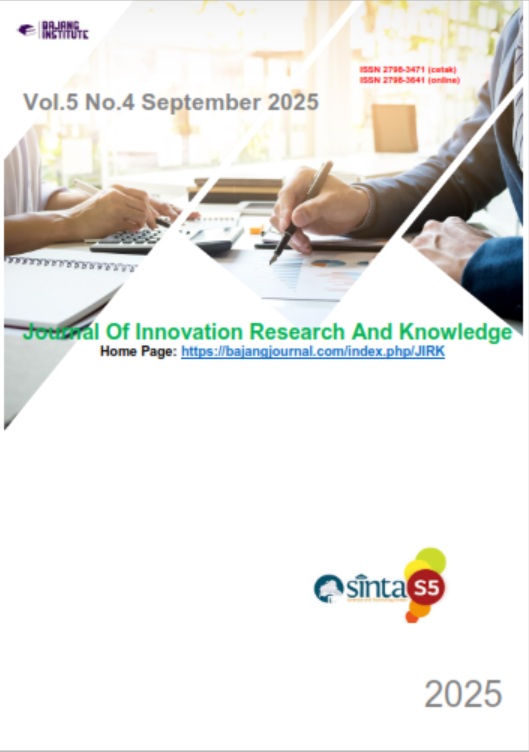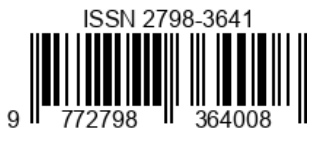ANALISIS REJECT FILM DIGITAL RADIOGRAFI DI INSTALASI RADIOLOGI RSUD SIDOARJO BARAT
DOI:
https://doi.org/10.53625/jirk.v5i4.11246Keywords:
Film Rejection Analysis, Radiology Department, Digital Radiography, Causative factorsAbstract
Background: Reject analysis is an evaluation of rejected radiographic results. At the Radiology Department of Sidoarjo Barat General Hospital, the recording and evaluation of rejected films have not been optimally implemented despite the use of Digital Radiography (DR) technology. There are still radiographs that are rejected without adequate documentation and analysis. This study aims to identify the causes of rejection, the percentage of rejected films, and the recording and analysis systems in place. Method: The study was conducted from October 2024 to July 2025 using a mixed-method approach (qualitative and quantitative). The qualitative approach involved observation, interviews, and documentation of radiographers and medical physicists, as well as analysis of secondary data from regulations and publications. The quantitative approach involved collecting data on the total number of digital images and rejected images. The rejection rate was calculated using the formula: (number of rejected images ÷ total number of images) × 100%. Results: The film rejection rate was recorded at 0.84% (8 films out of 946 uses) in October 2024 and increased to 1.96% (23 films out of 1,173 uses) in November 2024, and 1.28% (13 films out of 1,012 uses) in December 2024. The total number of film uses from October to December was 3,131 films. The causes of film rejection included human error (2.72%), tool error (3.86%), foreign objects (0.90%), fog (0.68%), and patient error (1.81%). Tool error was the most common cause. The most common type of examination with rejections was lumbosacral, while the lowest was femur. Conclusion: The implementation of data collection on the factors causing film rejections does not yet comply with regulations. The researcher recommends paying attention to the evaluation of film rejection analysis in radiology department management to ensure quality assurance continues to operate safely
References
Arief, T. I & Dewi, L. S. 2017. Manajemen Mutu Informasi Kesehatan I. Jakarta
Bapeten. 2023. “Peraturan Pemerintah Republik Indonesia Nomor 45 Tahun 2023 Tentang Keselamatan Radiasi Pengion Dan Keamanan Zat Radioaktif.” Peraturan Pemerintah Republik Indonesia Nomor 45 Tahun 2023 Tentang Keselamatan Radiasi Pengion Dan Keamanan Zat Radioaktif. Https://Doi.Org/Https://Jdih.Bapeten.Go.I /Id/Dokumen/Peraturan/Peraturan-Pemerintah-No-45-Tahun-2023-Tentang-Keselamatan-Radiasi-Pengion-Dan-Keamanan-Zat-Radioaktif.
Biloro, Abdul Rahman, And Universitas Aisyiyah Yogyakarta. 2024. “Jurnal Dinamika Kesehatan Terpadu Jurnal Dinamika Kesehatan Terpadu” 5 (4): 47–54.
Fajarrissetyo, Ikko Justian, Panji Wibowo Nurcahyo, And Asri Indah Aryani. 2015. “Analisis Penolakan Dan Pengulangan Citra Radiografi Pada Modalitas Computed Radiography Agfa Cr 35-X Di Instalasi Radiologi Rsud Dr. R. Goeteng Taroenadibrata Purbalingga.” Jurnal Imejing Diagnostik (Jimed) 1 (2): 78–81. Https://Doi.Org/10.31983/Jimed.V1i2.3159.
Harun, Herlinda Mahdania, Musdalifah Musdalifah, And Sumarsono Sumarsono. 2022. “Faktor Reject Film Radiografi Menggunakan Computed Radiography Di Rs Bhayangkara Makassar.” Lontara Journal Of Health Science And Technology 3 (1): 32–37. Https://Doi.Org/10.53861/Lontarariset.V3i1.268.
Jannah, Yustin Nurul, Widya Mufida, And Ike Ade Nur Liscyaningsih. 2021. “Analisis Faktor Penyebab Reject Film Pada Pemeriksaan Radiografi Gigi Intra Oral.”
Kemenkes. 2020. “Keputusan Menteri Kesehatan Republik Indonesia Nomor Hk.01.07/Menkes/316/2020 Tentang Standar Profesi Radiografer” 2507 (February): 1–9.
Kesehatan, Menteri. 2008. “Menteri Kesehatan Republik Indonesia Nomor : 129/Menkes/Sk/Ii/2008.” Menteri Kesehatan. Https://Doi.Org/File:///C:/Users/Acer/Downloads/Kepmenkes%20129%20tahun%202008%20-%20standar%20pelayanan%20minimal%20rs.Pdf.
Lampignano, John P, Bontrager Dan Kendrick, Leslie E. 2018. Textbook Of Radiographic Positioning And Related Anatomy. Ninth Edition. Mosby. A Harcourt Health Company St..
Mesfin Zewdu, Elias Kadir, Melkamu Berhane. 2017. Analysis And Economic Implication Of X-Ray Mafilm Reject In Diagnostic Radiology Department Of Jimma University Specialized Hospital, Southwest Ethiopia. J Health Sci 2017;27(4):421.
Moskop, John C. 2016. Ethics And Health Care: An Introduction. Ethics And Health Care: An Introduction. Https://Doi.Org/10.1017/Cbo9781139058575.
Papp Jeffrey. 2019. Quality Managementin The Imaging Sciences. File:///C:/Users/Acer/Appdata/Local/Microsoft/Windows/Inetcache/Ie/Jz5q1j7j/Jeffrey Papp - Quality Management In The Imaging Sciences-Elsevier Health Sciences (2014)[1].Pdf.
Suraningsih, Nanik, Siti Rosidah, And Fadli Felayani. 2015. “Analisa Penolakan Radiograf Di Instalasi Radiologi Rumah Sakit Bhayangkara Semarang.” Jurnal Ilmu Dan Teknologi Kesehatan Stikes Widya Husada Semarang 6 (1): 7–14.













